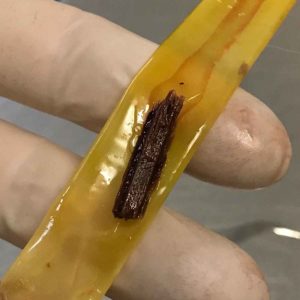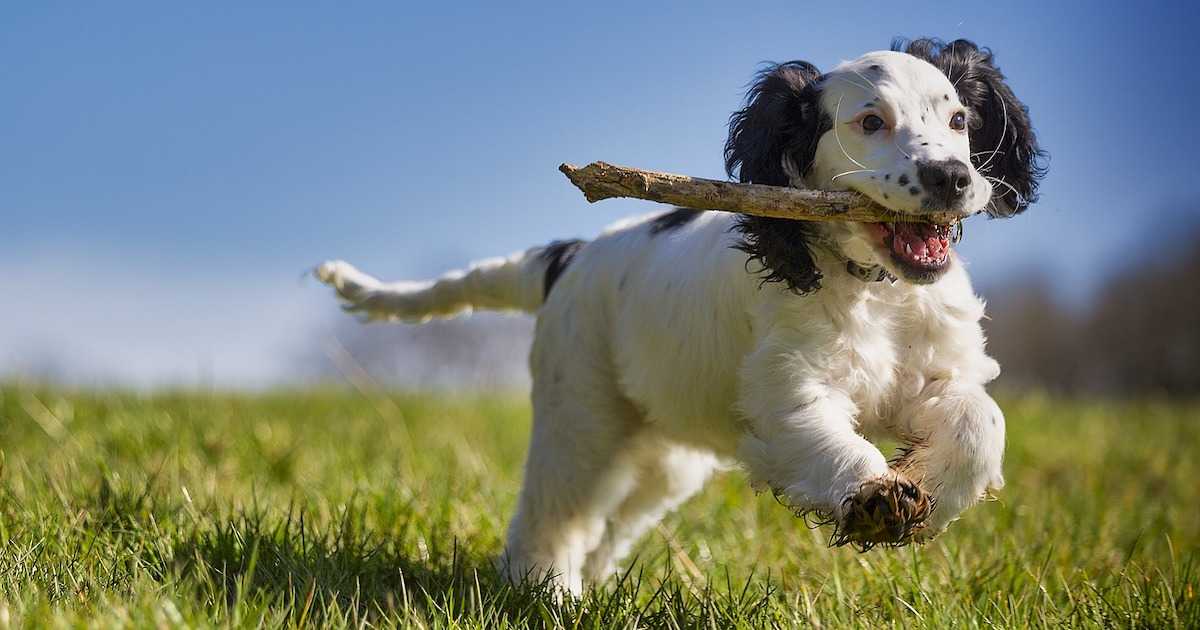Updated November 28, 2020
What’s more natural than throwing a stick for a dog? We love it, they love it too, and every park is a toyshop. That’s why so many dogs get injured.
When we throw a stick it usually rotates in the air, but that’s OK. The odds are that when it reaches the dog, it will be roughly sideways and that it will hit the ground before your dog gets to it. However, bad luck has it that sometimes both of those two things don’t happen:
- Your dog gets under it before it lands
- It will be precisely end-on at the moment your dog leaps for it
This is what happened to a recent dog named June. The stick entered her mouth and forced its way into the throat. Horrible to imagine and no doubt worse to experience. This is just one of the ways sticks can hurt dogs.
Types Of Stick Injuries

There are at least four types of injuries caused by sticks.
- Injury to the mouth and throat while catching
- A similar injury when running and carrying sticks in the mouth
- Stake injuries from running into sticks that land pointing up
- Infection from wood fragments left behind
The last one is (believe it or not) the most important, as you’ll see later.
What Stick Injuries Look Like
When a dog is hurt, they will usually cry out, but there’s surprisingly little blood. If you can’t see the stick or blood, other clues that it happened can be:
- Yelping suddenly while playing
- Drooling excessively
- Unwillingness to eat or drink
- Unusual lethargy or quietness after play
- Difficulty breathing
- Pain and swelling
I have seen plenty of cases where the initial injury was missed. Over time these develop an increasing difficulty eating, bad breath and sometimes a painful swelling as the infection takes hold.
From Bad To Worse
These injuries are bad enough, but worse is to come. If there’s one mistake that vets and owners make, it’s assuming that all the stick came out.
The reality is that even if a stick seems to come out intact, it usually leaves behind small fragments. These then set up an infection that is difficult or impossible to control without removing the foreign material.
The problem is that small stick fragments are extremely hard to find. That’s why most deaths from stick injuries are due to infection, not trauma. Let’s return to June’s case as an example.
June’s Lucky Break
After the accident, June was taken to her closest emergency vet. They recognised the danger and stabilised her with a plan to have specialist surgery the next day.
Under anaesthetic, a wound was discovered near her tonsil. Using a probe, it was found to follow the path of the stick as it forced its way down her neck. Luckily it had managed to miss all the vital structures on its way. There was no sign of anything left behind, so they placed a drain and stitched her wound.

That’s her on her way home the next day. You can see from the position of the drain how far the stick had travelled. Over the next few days, she recovered well on pain relief and antibiotics. That’s where I came in.
She visited me for her scheduled drain removal. All looked good so I took out her drain, and nearly fell over backwards in surprise. There stuck to the drain was a large piece of wood.
The Relapse
I can’t express how lucky this is. However, even with the stroke of good fortune, she wasn’t out of danger. A few days later, once her antibiotics stopped, a swelling appeared in her neck.
I took one look at it and said, “there’s still more wood in there.” As she was otherwise well, I put her back on antibiotics. The swelling subsided, and this time it didn’t flare up again at the end.
I saw her the other day and although she’s 100% fine, there’s still a small lump on that side. It’s likely that a tiny piece of wood remains, and the body has ‘walled it off’. Knowing the difficulty and trauma associated with any further attempts to find it, I’m very happy to let sleeping dogs lie. If it ever does cause problems, I will recommend a CT or MRI first.
All dog lovers should be grateful to June’s owners for sharing her story. By spreading the word, we can make these horrible injuries rare. From now on, when you see someone throwing sticks, or are tempted by your begging dog, you’ll have the strength to say “no, how about we play with anything else”.
Related: Why tennis balls aren’t good for dogs either!
Have something to add? Comments (if open) will appear within 24 hours.
By Andrew Spanner BVSc(Hons) MVetStud, a vet in Adelaide, Australia. Meet his team here.

